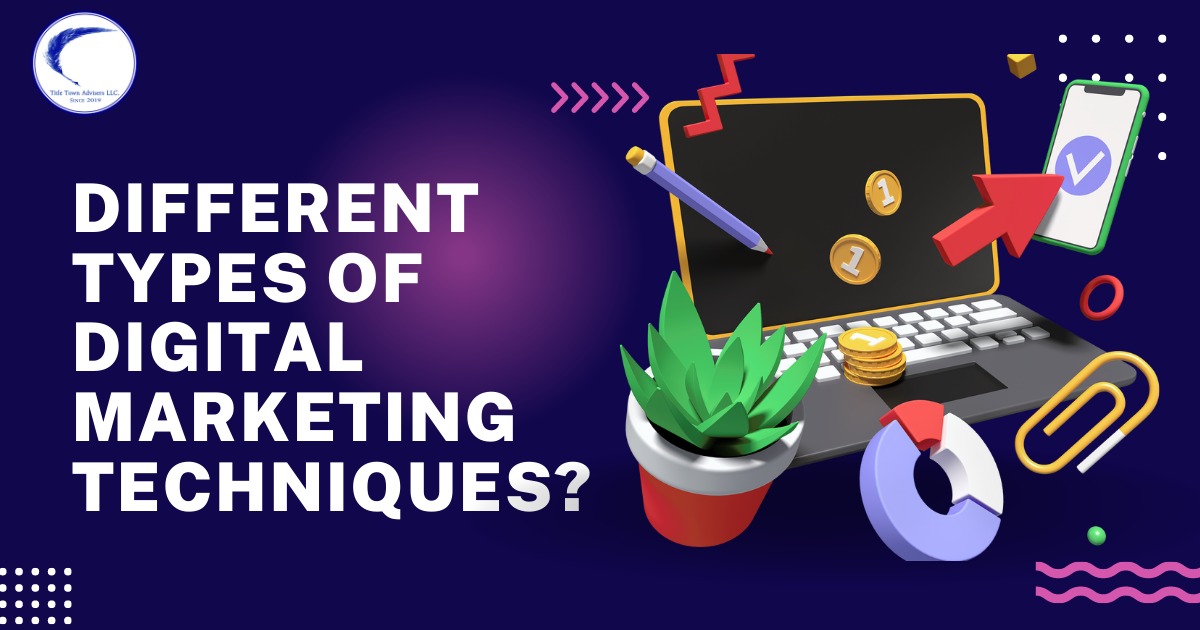Different Types Of Digital Marketing Techniques ? has become one of the most crucial aspects of business growth. There appear to be loads of different branches within it. From SEO to PPC and content to affiliates, let us see how types of digital marketing are there?
Search Engine Optimisation (SEO)
SEO is a form of digital marketing that uses techniques that improve the performance of your website organically. By implying this, the website appears higher up on the Search Engine Results Page, commonly known as SERPs. As a result more people are likely to discover your brand or business. Search engines such as, Google use bots that crawl everything on the pages of websites present on the internet. When a bot crawls a page, it reads all of the information on that page to index it appropriately. Once indexed, it can discovered by real people searching on the internet – sort of like a library.
SEO fundamentals
SEO is the digital marketing technique that ensures your website pages appear organically at the top of SERPs. The fundamentals of SEO include:
Different Types Of Digital Marketing Techniques?
- High-Quality and Relevant Content: writing good, relevant content that matches user intent and offers unique and authoritative information
- Keyword Optimization: Include relevant keywords within your content so its more likely to be served in SERPs for those search terms.
- Strong site structure: creating a site structure that makes sense and is easy to understand so that both humans and bots can navigate your website with ease.
- User experience and site speed: Make sure that the customer journey on your site is easy and that your pages and content are loading in less than two seconds.
There is a right and a wrong way to do SEO. You can easily distinguish between them as white hat and black hat SEO. White hat SEO uses all of the industry best practice techniques to boost the organic performance of your site. On the other hand, black hat SEO harnesses all of the practices that are consisdered to be cheating the system.
Any Professional SEO provider will only use white hat SEO strategies. If you’re caught using black hat SEO, you can face the consequences of your actions as Google can issue you with a penalty and even strip your site of all its rankings.
Content Marketing & Organic Social
Different Types Of Digital Marketing Techniques? Falls under organic SEO and refers to the use of content to improve SERP rankings. To optimize for keywords, you first need to create quality content for them to sit within.
Before Google’s bots and algorithms, people could stuff keywords into their content, in a rather unnatural way, so that it would appear in the top results of a search. However, Google, and other search engines, soon figured out what was going on and developed more sophisticated algorithms to stop this.
Now, content must be fresh, unique, and authoritative for it to rank well in SERPs. That requires a fair amount of planning and keyword research to make sure you are getting the most out of your content marketing strategies. Content doesn’t even have to be just words on a page. It can include things like videos, infographics, and social media – to name a few.
Organic social, in particular, is a huge opportunity to grow your brand online. The main benefit of organic social is that your followers will be genuine, real customers. Unlike paid digital marketing, organic social is a long-term, more sustainable way of improving your online presence.
PPC (pay-per-click)
PPC (pay-per-click) is a model of internet advertising whereby advertisers are charged every time one of their ads is clicked on. When you do a Google search for certain keywords, you’ll notice that the first few results are marked as ads. That’s because advertisers are bidding on certain keywords so that they can appear first. Every time an ad spot becomes available, an auction takes place instantly for that keyword. Winning depends on several things including the bid amount and the quality of the ad itself. One of the core benefits of PPC is that you will be able to see results, fast. SEO can take months to start showing progress as it’s an organic process. When it’s paid for, you can drive traffic to your site almost instantly in some cases. The flipside of that is that as soon as you stop running a PPC campaign, you will notice a drop in traffic and sessions on your site.
Paid social
Paid social is a form of paid media and is when advertisers pay for their ads to appear on social media channels. Ads in paid social can come in the form of standard advertisements or sponsored posts. Any time you pay money for your brand to be promoted on social media counts as paid social.
As with PPC, paid social enables you to get your brand seen by the right people at the right time. Something increasingly difficult in the over-saturated world of social media. It also allows you to target your consumer at an incredibly granular level. Plus, from a content marketing perspective, paid social can help to get all of your great content seen by more people.
Of course, every platform is different. Instagram is very visual whereas Twitter is all about the short, snappy written word. So, your paid social campaigns and strategies should be tailored to each. Every social platform has its ad center. Here, you can set your campaigns as live, edit them and end them. They will even give you measurables, like engagement, so you know how well your campaign has performed.
Affiliate marketing
Different Types Of Digital Marketing Techniques. Affiliate marketing is a type of performance marketing where businesses pay partners a commission every time a user buys something through their links. Anyone with a website can be an affiliate partner. All you need to do is promote a company’s product and or service online. If someone uses a link through your site to buy something, you’ll earn money from it.
Here’s how it works:
- A website owner joins an affiliate program
- They then include links on their website to a businesses website – most likely to a specific product page
- If a customer clicks on that link, they are sent to the product page via a tracking link
- If they buy something through that tracking link, the website owner earns a commission
As a business, you can pay per sale, per lead, or per click. It all depends on your campaign objectives. By using affiliate marketing you can choose the websites that promote your products. This means you can tap into your core audience by promoting your products on sites they frequently visit. You also don’t pay for anything unless a user buys something. So, up until that point, it doesn’t cost you a penny – unlike other types of digital marketing.




0 Comments